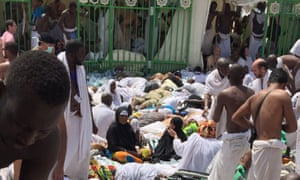The Guardian
Link
The death toll in a stampede outside Mecca has risen to 717, with at least 800 injured, the deadliest disaster on the annual hajj pilgrimage in over a quarter of a century.
The crush happened in the Mina valley, a few miles outside Mecca, where a sprawling camp of 160,000 tents fills with millions of visitors for a few days each year.
Tragedy hit when two large groups of pilgrims who were preparing for one of the last major rites of their trip met on an intersection of two roads, Saudi authorities said.
The crush left bodies of victims and injured survivors heaped in chaotic piles on the street in blazing desert heat, videos and photographs from the site showed.
Over 4,000 rescue workers raced to the scene to offer first aid and load the most critically injured people into rescue helicopters and hundreds of ambulances.
The stampede is the deadliest disaster at the hajj since a similar tragedy in 1990, when more than 1,400 people died after panic broke out among crowds inside a tunnel.
It is also the second deadly disaster in Islam’s holiest city this month, after a construction crane collapsed on 11 September, killing more than 100 people and injuring more than 200.
The latest deaths are likely to raise questions about Saudi authorities handling of safety during the hajj pilgrimage, when 2-3 million people travel to Mecca.
Mina has been a particular focus of concerns, because thousands of people had died in past stampedes and fires on the cramped streets of the temporary tent city.
Saudi authorities have spent millions trying to improve safety, including expanding the “Jamarat bridge”, where pilgrims throw pebbles at three walls in a symbolic stoning of the devil [It Looks Like the Devil Won Today!] into a multi-storey building with entrance and exit ramps.
Pilgrims continued to arrive at the site despite the stampede. “Work is under way to separate large groups of people and direct pilgrims to alternative routes,” the Saudi civil defence directorate said.
The hajj pilgrimage is one of the five pillars of Islam, and it is a religious duty for able-bodied Muslims to make the journey at least once in their lives.



No comments:
Post a Comment